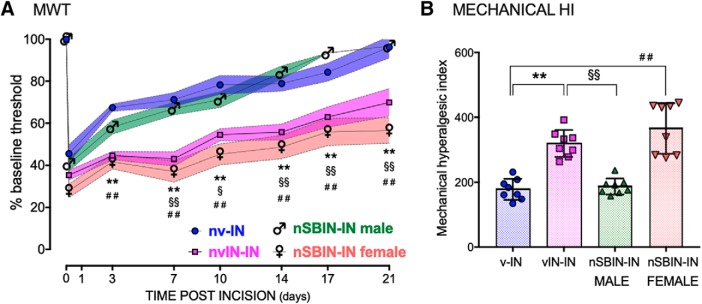Figure 4.
Mechanical hyperalgesia following adult reincision is sex-dependently influenced by intrathecal SB203580 at the time of neonatal incision. A, Changes in mechanical withdrawal threshold following incision are normalized as percentage change from baseline (adult preincision). Within the nv-IN and nvIN-IN groups, data did not differ between males and females, and are combined. The impact of prior neonatal incision is highlighted by the clear separation in both the degree and duration of hyperalgesia (nv-IN vs nvIN-IN: **p < 0.001). In males, SB203580 at the time of neonatal incision attenuated the enhanced reincision mechanical hyperalgesia from 7 to 21 d (♂ nSBIN-IN vs nvIN-IN: §§p < 0.001; §p > 0.05). In females, neonatal SB203850 has no effect; enhanced adult reincision hyperalgesia persists 3–21 d following incision (♀ nSBIN-IN vs nv-IN: ##p < 0.001). Data points are mean ± SEM, analyzed by two-way repeated-measures ANOVA with Bonferroni post hoc comparisons. n = 8 animals per group. B, The mechanical hyperalgesic index (area over the curve 0–21 d after incision) identifies enhanced reincision hyperalgesia (nv-IN vs nvIN-IN: **p < 0.001) that is reduced by neonatal SB203580 in males only (nSBIN-IN males vs nvIN-IN: §§p < 0.01). In females, enhanced hyperalgesia persists (nSBIN-IN female vs nv-IN: ##p < 0.01). Data points are individual animals (n = 8 per group). Error bars indicate mean ± SD, analyzed by two-way ANOVA with Bonferroni post hoc comparisons.

